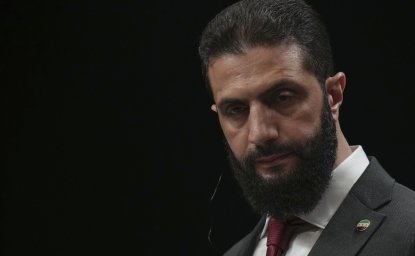The White House Caves to Syria’s Assads—Once Again


On the eve of the 5th anniversary of Syrians’ uprising against the government of Bashar al-Assad, the Obama administration is yielding to the Syrian President’s steeled determination to remain in power and the kingpin of the Levant. This is history repeating itself. Whether occupied by a Republican or Democratic president, the White House has never had the stomach for a knockdown battle with Syria’s ruthless Assad rulers: neither Hafez the father in the mid-1980s nor Bashar the son today.
It is amazing how fast U.S. presidents and policymakers have repeatedly changed their minds about whether there is any vital U.S. interest at stake in Syria and whether confrontation or accommodation with the bloody Assad regime is the wiser course.
Obama insisted emphatically for five years that Bashar al-Assad had to give up power as a core element to any solution to the bleeding Syrian conflict. But now he has agreed with Russian President Vladimir Putin to an 18-month transition plan that allows Assad to stay at least until the end of the process—and likely much longer. It would depend on new presidential elections, but the Assads have seen to it that they always win for the past 45 years.
Another round of negotiations between the Assad regime and an array of rebel groups dispirited over signs of U.S. abandonment start today in Geneva under UN auspices. Obama is clearly leaning toward at least a short-term accommodation with Assad to extract his administration from a deeper entanglement.
Far more is at stake today than the last time the United States cut and ran from this country: in 1984 when Syria, backed then as today by its Lebanese allies and Iran, stood up to the U.S. military intervention ordered by Republican President Ronald Reagan.
As the Washington Post’s Middle East correspondent in the early 1980s, I covered that disastrous U.S. plunge into the Lebanon civil war on the heels of the Israeli invasion there in a bid to chase the Palestinian Liberation Organization (PLO) out of the country. First Israel and then the United States also had to confront Syria, which had committed ground troops and its air force in defense of the PLO and its own hegemony over Lebanon.
The country had become a chaotic mess of contending Palestinian, Sunni, Christian, and Shi’ite factions into which the central government had sunk into near oblivion. Israel did achieve its main objective of forcing the PLO to leave Lebanon in September 1982 under the supervision of the Multinational Force in Lebanon (MNF), a hoped-for peacekeeping operation consisting of U.S., French, and Italian troops.
The Reagan administration jumped into the Lebanese civil war with gusto. It backed the Lebanese president, a thuggish extreme rightwing Christian named Bashir Gemayel, groomed by the CIA for leadership and vehemently anti-Syrian and pro-Israeli.
To demonstrate the United States meant business, Reagan ordered up a little shock and awe display of U.S. military might. The Pentagon took the World War II battleship USS New Jersey out of mothballs, gave it the motto “Firepower for Freedom,” and stationed it off the Lebanese coast. Its signature firepower was its mammoth 16-inch guns capable of firing shells so big they were nicknamed “flying Volkswagen Beetles.” They indeed went flying onto Syrian military positions as well as those of its Lebanese Shi’ite and Druze allies in the mountains overlooking seaside Beirut.
Meanwhile, Reagan tried to sell Americans on the idea that the United States had a “vital interest” in Lebanon because “the region is central to the economic vitality of the Western world,” and he pledged to keep troops there until “internal stability is established.” U.S. reporters were astonished to hear that even Souk el-Garb, a tiny Christian village on a mountain ridge behind Beirut threatened by Syria’s Druze allies, was part of the U.S. vital interest and thus a legitimate target for the USS New Jersey’s big guns.
The results of the U.S. intervention were catastrophic. They included the birth of the Lebanese Shi’ite extremist group, Hezbollah, and the initiation of deadly terrorist attacks engineered by Syria and Iran against U. S. facilities and personnel, first in Lebanon and then elsewhere in the Middle East.
Gemayel was assassinated in September 1982 by a Syrian-backed Lebanese operative. Then in April the following year, a suicide bomber drove a van loaded with 2,000 pounds of explosives into the U.S. embassy in Beirut, killing 63 people of whom 17 were Americans, including the top CIA Middle East analyst, Robert Ames.
There was a lot worse to come. On October 23, 1983, another suicide bomber driving a truck laden with 21,000 pounds of TNT plowed into the barracks housing U.S. Marines participating in the MNF outside the Beirut international airport. It killed 241 U.S. servicemen including 220 Marines, setting a record for the largest number of U.S. military personnel to die in a single incident since World War II.
The following February, Reagan ordered the withdrawal of remaining U.S. troops to ships off-shore and the return of the USS New Jersey to its mothballs, acknowledging Syrian hegemony over Lebanon and the absence of a real vital U.S. interest there.
Now it is Obama’s turn to decide whether to cut and run in the face of Assad’s refusal to buckle under U.S. demands and threats. Five years ago, in the exuberance of the Arab Spring, the president verbally committed American power to regime change in Syria and forcing Assad from power. Saudi Arabia, other Gulf Arab states, Turkey, and a motley array of Syrian rebel groups took Obama for his word. But Obama dithered and never walked his talk. He never ramped up a serious training program for the rebels or gave them the weapons they needed to prevail.
Now that Russia has come to the rescue of Assad’s regime with a lot more shock and awe than the USS New Jersey battleship, Obama is struggling to define any U.S. vital interest in Syria sufficient to justify escalating rather than ending U.S. aid to the Assad opposition.
In his comments at the Annenberg Retreat in California on February 16 this year, Obama readily acknowledged the stakes are enormous for the long-suffering Syrian population, the stability of the region, the battle against the Islamic State, and the future of Europe swamped by Syrian refugees. But the term “vital American interest” was conspicuously absent.
Ironically, the main rationale for any U.S. military involvement in Syria in Obama’s mind has always been the defeat of the Islamic State. But were the United States to succeed in that goal, one of the main beneficiaries surely would be Assad, still the nemesis of American foreign policy in the Levant. Meanwhile, Syrian rebel groups report that Washington has begun cutting on arms and munitions to even “moderate” ones. Can the runaway part of the new Obama strategy toward the rebels be far behind?
The opinions expressed herein are those of the author and do not reflect those of the Wilson Center.
Author

Former Washington Post Middle East Correspondent

Middle East Program
The Wilson Center’s Middle East Program serves as a crucial resource for the policymaking community and beyond, providing analyses and research that helps inform US foreign policymaking, stimulates public debate, and expands knowledge about issues in the wider Middle East and North Africa (MENA) region. Read more

Explore More
Browse Insights & Analysis
Can Climate-Resilient Agriculture Become an Engine for Syria’s Post-Conflict Recovery?


